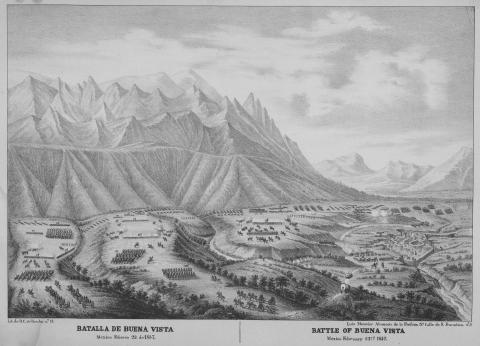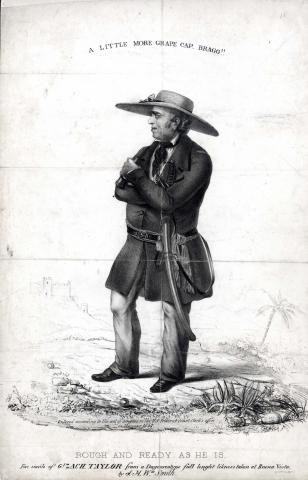Biographies | Correspondence | Diaries & Journals | Music & Poetry | Newspapers | Pamphlets & Almanacs | Images | Maps | Speeches & Oration
Fought on February 22-23, 1847 near Saltillo, the Battle of Buena Vista (La Angostura) was one of the most important battles of the U.S.-Mexico War.
Having learned that an invasion of Vera Cruz was imminent, Santa Anna resolved to move first against Taylor's now weakened army. At San Luis Potosi, about 250 miles south of Saltillo, the Mexican president assembled an army of conscripts and the remnants of the army defeated by Taylor at Monterrey. Bitterly cold weather slowed the march north, with some 3,000 troops deserting along the way.
Skirmishing between the two sides began on February 22, and the following day Santa Anna attacked Taylor's carefully chosen defensive position at Buena Vista, a hacienda in La Angostura Pass six miles south of Saltillo. Twice the Mexican infantry came close to turning Taylor's left flank, but were eventually turned back, owing to the timely arrival of U.S. reinforcements from Saltillo and effective American artillery. In the afternoon, Santa Anna ordered a massed assault against the center of Taylor's line, where the U.S. general had concentrated his artillery. Again Mexican troops almost succeeded in driving the U.S. army from the field, but were finally repulsed by withering cannon fire.
Taylor anticipated an attack the following day, but during the night Santa Anna gave the order to withdraw. His supplies exhausted and his troops hungry, Santa Anna retreated to San Luis Potosi. Taylor declined to pursue the Mexican army, and withdrew to Monterrey, having fought his last battle of the war.
Both generals claimed victory, although little had been gained by either side. While Taylor's Army of Occupation remained in control of northern Mexico, this was the closest Santa Anna would come to reversing Mexico's fortunes on the battlefield.
U.S. press accounts of the battle at Buena Vista greatly enhanced Taylor's standing as a potential presidential candidate in 1848. Other prominent U.S. political leaders also gained renown in the battle, such as Jefferson Davis and Franklin Pierce. A notable casualty was Henry Clay Jr., the 35-year-old son of Whig leader Henry Clay, an outspoken opponent of the war.


